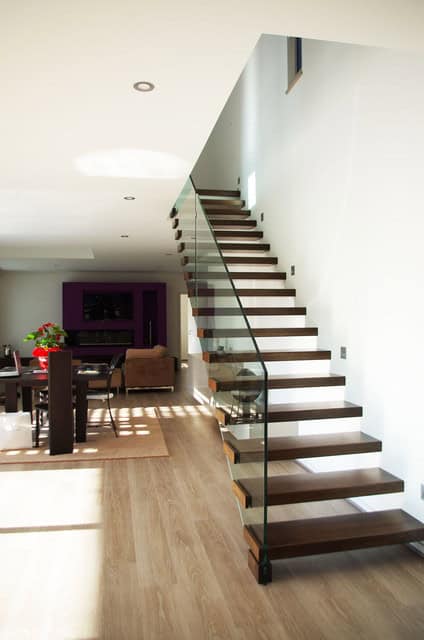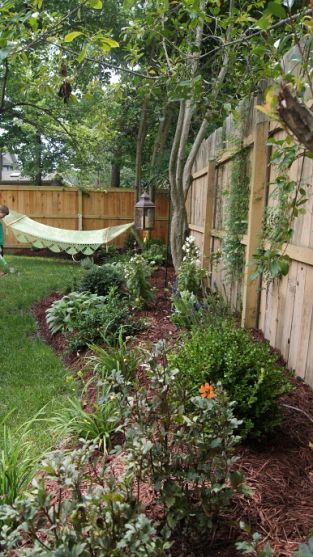Slot In Fence Posts
There are two common basic methods of constructing rails for board fencing, the easiest method is to have the rails on the front of the posts then fitting the boarding along the whole length. The alternative method is to fit the rails between the posts (with their front faces about 25 mm back from the front of the posts, and then fix the boards between the posts.

The rails
Two types of rails are commonly found - arris rails with a triangular cross-section, and cant rails which are more or less rectangular with the top edge sawn at an angle to allow rainwater to run off away from the fence boards.
Fitting a fence panel that is 6 foot wide on your own is difficult due to normal arm reach but here is a solution I came up that made it so much easier.
- When the concrete has hardened, go along the posts and drive a nail, at an angle, in the front of each post to secure the tongue of each rail in the post slot. Using cant rails on the front face of the fence posts. Erect the posts as described above at no more than 3m (10ft) spacing and secure them using concrete.
- Grand Empire 4-in x 4-in W x 4-1/2-ft H Black Steel Universal Fence Post. Compare; Find My Store. For pricing and availability.

Traditionally arris rails had tongues cut at their ends which fitted into slots cut in the posts. The tongues took the full weight of the forces on the fence, so they often broke after a time.
Slot In Fence Posts Barbed
Galvanised steel repair brackets, which are available in a number of designs to suit both arris and cant rails could be used to repair broken rails as necessary. These repair bracket can be used when constructing a new fence, they avoid having to spend a lot of time cutting the tongues and slots.
Unless the boards are going to be fitted between the posts, it is simpler to use cant rails (with their vertical back edge) and fix them across the front of the fence posts.
Concrete posts can be used and the cant rails secured to the posts by bolts with their heads recessed into the rails using suitable holes though the posts, or special posts are available to take metal brackets to suit the type of rail being used.
In general, rails should be positioned no greater than about 200 mm (8 inches) down from the top of the boards or up from the bottom. Vertical spacing between rails should be no greater than about 700 mm (28 inches). This allows for a fence up to about 1.1 m (43 inch) to be built with just two rails, while fences over that should have 3 rails with the middle rails equally spaced vertically between the upper and lower rails.
Erecting the posts and rails

The traditional slotted arris rails.
If the posts being used do have have slots already cut to accept the trimmed arris rails, the first job is to cut the slots. The slots can be simply made by drilling three, overlapping holes all the way through the posts using a 20mm (7/8in) flat bit in an electric drill. To clean up the holes, use a chisel to remove the surplus wood in the slot.
The ends of the arris rails should be trimmed using a saw and finished off with a file so they are a snug fit in the post slots.
Before assembly, paint the slots and ends of the rails with wood preservative. Start by erecting one end post ensuring that it is vertical. Stretch a string line along the proposed run of the fence to the end of the fence run to ensure that subsequent posts are in line.
Set out the intermediate posts, try to keep them equally spaced with no more than 3m (10ft) between each pair. Dig a hole for the second post and push the ends of each arris rails into the slots in the first two posts.
Use timber struts to temporarily hold the posts upright, and check with a spirit level that the rails are horizontal (unless the ground is on a slope in which case, check that the rails are in the line of the general slope). If necessary dig the hole deeper, or pack it up with broken bricks, to get the post at the correct level.
Continue in this manner with the third and subsequent posts until all the posts and rails have been completed. If it is impossible to move the last post sufficiently to allow the rails to be fitted in the slots, the last rails can be sawn off square and attached to this last post using galvanised rail repair brackets.
With all the posts inserted and temporarily strutted, hard-core can be rammed around each (ensure that each remains vertical) and fixed permanently using concrete (see fence posts) at soil level. When the concrete has hardened, go along the posts and drive a nail, at an angle, in the front of each post to secure the tongue of each rail in the post slot.
Using cant rails on the front face of the fence posts.
Erect the posts as described above at no more than 3m (10ft) spacing and secure them using concrete.
When the concrete has hardened, the cant rails can be fixed to the front face of each pair of posts. The rails can be fixed either in line with the next, or staggered. By staggering then, a stronger fixing may be achieved as the nails are not so near the ends of the rails as the other joints.
I’m working on a new woodworking project that involved cutting through-slots for bolts in a couple of boards. The two boards will act as adjustable arms to hold a dowel handle for a garden cart.
I have cut shorter and narrower slots using a table-mounted router for a coin bank. These bolt slots were considerably longer and 1/4' wide so I was reluctant to use the same technique. I don’t have a plunge router – which would probably be the fastest and easiest way to do this.
Crowd-sourcing ideas
Slot In Fence Posts Post
After checking a couple of woodworking forums for ideas – including one where someone trying this on a router table said the board 'shattered' (yikes!) – the general consensus seemed to be todrill out most of the material and clean up the slot later with a coping saw.
That sounded good (and safe) to me.
Since my slot was only 1/4' wide, I decided best approach was to use a 1/4' Forstner bit in a drill press to define the slot and remove most of the material, then clean up the slot with a file and sandpaper.
The shaft on the 1/4' bit was larger than the bit itself so I had to flip the board over to drill all the way through the 3/4' material. It’s probably a good idea to do this anyway to avoid tear-out unless you have a backer board underneath when you’re drilling.
What to do
Drilling
- Mark the centre points for each end of the slot in the blank and use a nail or awl to punch a small hole for orienting the bit.
- Set up the drill press with a Forstner bit the same size as the slot you’re cutting. You’ll need to attach a fence to the drill press table to maintain a straight line as you drill along the length.
- Place the blank against the fence and lower the bit. Adjust the fence and blank so the point of the Forstner bit enters the small punched hole. Clamp the fence in place, slide the blank to the mark at the other end of the slot and check that it’s aligned properly.
- Put a mark on the edge of the board that’s against the fence. Keep this edge against the fence when you flip the board over and drill the other side. This ensures the holes are in line even if your a hair off centre of the board.
- Turn on the drill press and drill the each end hole to define the slot – drilling about two-thirds to three-quarters of the way through the board. After that, just keep drilling holes and moving the work piece along the fence, overlapping holes just enough to keep point of the bit entering new wood. The slot will fill up with shavings which you should clear out if they get in the way.
- Once you’ve drilled the length of the slot, clean it out with a screw driver or something similar. Flip the board over (keeping the same edge against the fence).
- Repeat the process starting with the end holes. It doesn’t matter which direction you work in.
A COUPLE OF NOTES:
- If you’re making a wider slot, you may want to make an additional pass to remove the 'peaks' between holes.
- If you have a mortising chisel & bit you could swap that in once you’ve drilled the end holes.

Cleaning up the slot
- After the drilling is complete, clean out the shavings with an awl or small screwdriver.
- Clamp the work piece on edge to your bench and use a flat file to remove the high points left between the drilled holes being careful not to hit the rounded ends of the slots.
- Wrap a small piece of sandpaper around a drill bit (smaller than the slot) to sand the ends of the slot.
- After filing off most of the rough surfaces in the slot, wrap some sandpaper around the file and use it to finish cleaning up the slot.
Slot Size In Concrete Fence Posts
If the slots were 1/2” wide or more, I probably would have used a jigsaw and straightedge to clean up the slots before sanding.